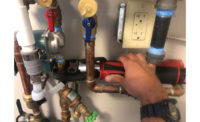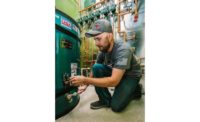Here in the Santa Fe, New Mexico, area — and all across the nation, it seems — everyone wants to be “green.”
So, we’re all in it together. But to a greater extent than most realize, HVAC installers are on the front lines day after day when it comes to protecting the environment and improving the energy efficiency of a home or business. Here at Outlaw Mechanical, we especially enjoy completing work that others deem impossible, all the while making a home comfortable in an efficient and affordable way.
Think about it for a moment: Although the idea may seem a bit lofty, the shoe fits — we truly are on the front lines. For some of us, it’s literally “trench warfare” while on the energy improvement battlegrounds here in the good ol’ USA.
Hydronically speaking, some of the most substantial “weapons” in our arsenal to fight for higher efficiency and sustainability are the latest generation of modulating condensing boilers (mod-cons) and the new, highly-efficient circulators and pumps that power circulatory systems large and small.
A mod-con may cost more than the last boiler the homeowners had installed 20 or 30 years ago, but the benefits can be enormous — increased comfort, decreased energy bills, and peace of mind. Customers will notice the 30 to 50 percent savings in fuel; the slower, more consistent heat across the floor, and the longevity of the unit (assuming regular maintenance is performed). In most cases, there’s even an unexpected space savings.
But be prepared for the battle to convert home or building owners.
Of course, there’s the obvious responses: “That little unit will never provide enough heat for our home,” or “Why would we need a fancy new ECM circulator and all those little whatchamacallems [zone valves]?”
Many of us have experienced these reactions. But if you’ve installed a low-mass, wall-hung hydronic system, you likely recall that moment of satisfaction — proving that sleek, new technology can win the day.
It’s also good to know, however, that many older homes are not very accepting of a new mod-con.
Can you properly vent the unit according to manufacturer specifications? Few things can be as tough to vent as a unit on a three-story apartment with the old equipment being in the basement, common vented in b vent, through an inaccessible mechanical vent chase. In this day and age, though, there are actually many solutions to these issues.
With the use of PVC/CPVC pipe, concentric vent kits, and polypropylene chimney liners, many of these issues can be resolved fairly simply. Investigate the market to find the solutions that best match your install scenarios. Be sure when giving a customer an estimate to thoroughly investigate the job, so you don’t lose money in the end due to venting woes.
Another thing to consider is where all the condensate is going to go. Hopefully your answer is not in the homeowner’s award-winning garden. Condensate can be tricky to get rid of, and, in some instances, a boiler can create more than 10 gallons a day. And whether it’s just a couple drops a day or enough to fill a small pool, the stuff is highly corrosive — so much so it will kill plants, eat concrete, and destroy cast-iron drains.
If you’re lucky enough to have a drain in the mechanical room, make sure you use a condensate neutralizer (I favor NeutraSafe and the Fireside fcn-60). For those who do not have a drain, plan your attack. Typically, condensate drains out so slowly that, if it’s simply drained to the outside of a structure by gravity, it may end up freezing, potentially backing up into the boiler and causing the boiler to shut down.
So, by all means, add a condensate pump to the system. Diversitech now makes a unit just for boilers that can handle hot condensate, and it’s built for corrosive pH levels.
Finally, for a high efficiency boiler to run optimally, give it context. A modulating condensing boiler needs to know where it’s at in terms of how best to control its operation — and to modulate properly. For a boiler to know what temp it is outside, it tempers its response by generating fluid temperatures best suited to the task. That’s one of the key advantages to these new systems, but they can’t do it properly — that is, to modulate — without the info it needs about ambient temps.
Of course, this is the job of outdoor reset. Surprisingly, many installers still aren’t convinced of their value. So I may just be one more voice of encouragement, but I can’t write this column without saying that outdoor reset technology is worth its weight in gold. In fact, I’ll bet ounce per pounce, they pay dividends worth a lot more than that shiny yellow metal. Not only for your customers, but for your self-respect as a professional, too.
Spend the time to learn the programming and effectiveness of this option. These little devices essentially tell the boiler how to run. As for the sensor itself, careful consideration is given to its location. If the logistics of getting a wire to it are too daunting, there are plenty of wireless options.
Finally, while we’re on the subject of controls, new thermostats are a must. To unlock the potential of improved energy efficiency, these devices play a valuable role. A Wi-Fi programmable thermostat will add to the efficiency based upon the heat delivery (baseboard, radiators, or infloor), not to mention that many customers today enjoy the option of controlling their home’s HVAC from their phones.
New, super-efficient hydronic tools, techniques, and components solve a wide variety of problems and make customers smile. Check ‘em out!
Publication date: 6/11/2018
Want more HVAC industry news and information? Join The NEWS on Facebook, Twitter, and LinkedIn today!








